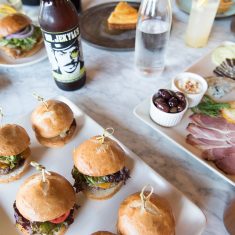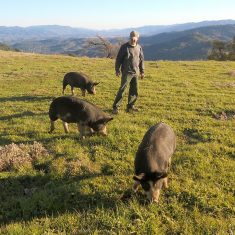Farm vs. Factory Part 1
Which came first, the recipes or the cow? The answer to this question may determine whether a restaurant’s menu is Farm Driven or Chef Driven. In a typical restaurant, the food concept is created, a menu is devised, and ingredients are purchased to piece those recipes together, i.e. Chef Driven.
The Golden Pig was founded to support its farm, Heart Arrow Ranch, in partnership with Mendocino Meats and other local farms in the area. First, we looked at the farm to see what was available and then crafted a menu using the entire animal – a total reversal of the norm – and the foundation of a Farm Driven restaurant.
Using whole animals with each carefully craft menu item has been a learning experience for us. The kitchen staff needs to know how to prepare and cook all the cuts of pork and beef. With poultry, any unsold whole rotisserie chicken is used for pot pie or nachos. Along with serving pork chops, the restaurant uses loin for schnitzel, belly for bacon, pork butt and picnic for pulled pork, and the head for paté. The cull sows are utilized and go into the signature all-pork hot dogs.
That’s why you’ll see our menu features “Select cuts”. Many meat eaters prefer specific select cuts, but all cuts of the animal must be utilized and sold at The Golden Pig, so very little is wasted. The time it takes to utilize an entire cow or pig was unknown in the beginning. Each cow, pig, and chicken is different from the one before. Ordering a steer means taking on about 400 to 500 pounds of trimmed and de-boned beef, but the exact amount is always different. Ordering a whole hog entails receiving 150 to 200 pounds of pork at a time. Consistency is very challenging.
At one end of the spectrum of meat production are small ranches that sell directly to customers and use holistic production models. At the other extreme, there is large-scale meatpacking, such as Tyson Foods and Cargill Meat Solutions. Commonly called factory farming, it is defined by efficiency, uniformity, and economy. However, it has a high cost when accounting for inhumane treatment of livestock, environmental pollution, and lack of flavor and nutrition in the final product. These are the meats pumped into McDonald’s Big Macs, chicken nuggets, and other fast food – convenient and cheap.
With factory-farmed pigs, the Yorkshire breed of pigs are prized for their lean meat, and Duroc pigs are valued for their fast growth, carcass yield (amount of edible meat from a carcass), and lean-gain efficiency. They are produced for volume and funnel easily from the “farm” (a CAFO, or confined animal feedlot operation) to processing to distribution. Whether you are a fast food restaurant or a fine dining establishment, it is much easier to execute your concept and buy pre-fabricated meat cuts to fit your menu.
The food system is not black and white. Medium-scale farms can use sustainable practices and produce a good final product – and also have the processing and distribution more accessible to them. A whole-hog barbeque joint in South Carolina may also use entire animals but purchase hogs raised in CAFOs.
For a Farm Driven restaurant like us, the menu is an authentic taste of the farm and the land, taking the whole animal from the local farm. Follow this three-part series over the next month.










